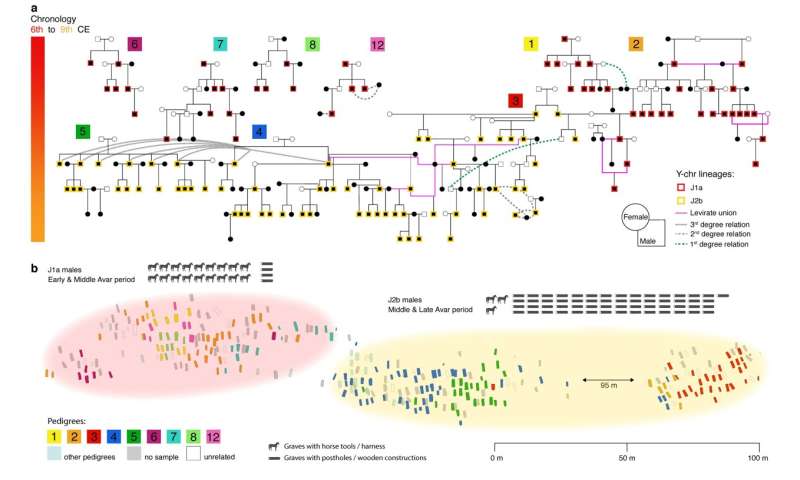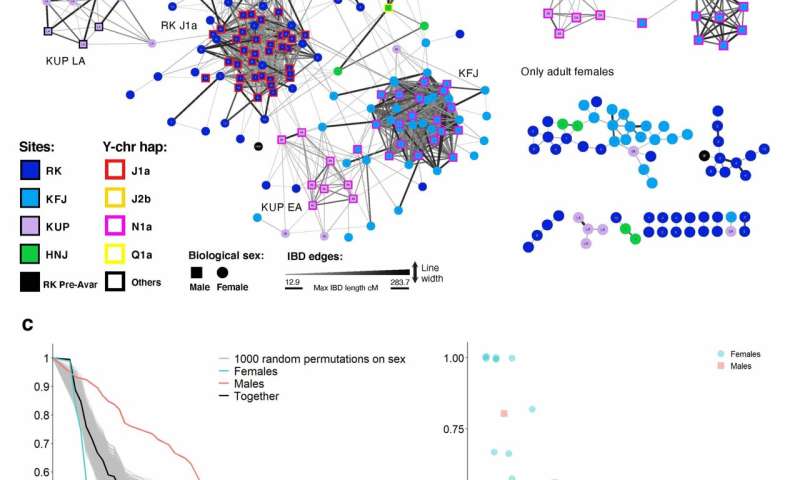Study reveals social organization of avar realm

A multidisciplinary research team including Patrick Geary, Professor Emeritus in the School of Historical Studies at the Institute for Advanced Study, together with Hungarian, Austrian, and German research groups, has combined ancient DNA data with a clear archaeological, anthropological, and historical context to reconstruct the social dynamics of Avar-period steppe descent populations that settled in Europe's Carpathian Basin in the 6th century.
Their research findings were published today in Nature.
The Avars, who had come from Eastern Central Asia, ruled much of Eastern Central Europe for a quarter millennium, from the 6th to the 9th century C.E. They may be less known than their less successful predecessors, the Huns. Yet in their cemeteries, they left one of the richest archaeological heritages in European history, including around 100,000 graves that have so far been excavated. From Avar funeral customs, and from written reports of their neighbors, scholars have reconstructed some of their social practices and ways of life. Yet now, archaeogenetics offers a totally new viewpoint on Avar communities who lived more than 1,000 years ago. We can now analyze the ways in which individuals were related to each other up to the sixth to tenth degree.
The historical knowledge on the Avar period populations was passed on by their enemies, mainly the Byzantines and the Franks, so information is lacking on the internal organization of their clans. Women are particularly underrepresented in historical sources, with only three incidental mentions, so knowledge of their lives is practically non-existent. It is known that some groups came to Europe from the East Asian and Pontic steppes, but to what extent were steppe traditions maintained in Avar society, if at all? How did the newcomer groups from the East interact with each other and with the population of their new homeland in Europe? In essence, how did their way of life change over time in a completely new environment after they left the steppes and abandoned their nomadic way of life?
Studying whole communities
Contrary to common practice in ancient DNA research, the team aimed to study whole communities and therefore focused on sampling all available human remains from four fully excavated Avar period cemeteries, analyzing entire communities by sampling all available human remains from four fully excavated Avar-era cemeteries, analyzing a total of 424 individuals and discovering that around 300 had a close (1st and 2nd degree) relative buried in the same cemetery. This allowed the reconstruction of several extensive pedigrees—the largest of which is nine generations deep and spans about 250 years—revealing that the communities practiced a strict patrilineal system of descent. Women played a key role in promoting social cohesion, linking individual communities by marrying outside their original community. Changes within a site indicated community replacement, probably linked to political changes, that remained genetically invisible, showing that genetic continuity at the level of ancestry can mask the replacement of whole communities, with important implications for future archaeological and genetic research.
The study was carried out by a multidisciplinary research team of geneticists, archaeologists, anthropologists, and historians, including researchers from the Max Planck Institute for Evolutionary Anthropology in Leipzig, Germany; the Institute of Archaeological Sciences, Eötvös Loránd University, Budapest, Hungary; the Curt Engelhorn Center for Archaeometry in Mannheim, Germany; and the Institute for Austrian Historical Research of the University of Vienna, Austria; as well as the Institute for Advanced Study.

Community dynamics
The researchers were able to identify communities that practiced a strict patrilineal descent system, where patrilocality (male individuals staying in the community after marriage) and female exogamy (female individuals moving to their partner's community after marriage) were the norm. Communities were locally centered around a main patriline and were related to each other through the systematic practice of female exogamy. Zuzana Hofmanová, senior author of the study, says, "In a way, this pattern shows the role of females in promoting the cohesion of this society, it was the role of females that connected the individual communities." Multiple reproductive partners were common. Several independent cases show that these communities practiced so-called levirate unions. This practice involves related male individuals (siblings or father and son) having offspring with the same female individual. Guido Alberto Gnecchi-Ruscone, first author of the study, adds, "These practices, together with the absence of genetic consanguinity, indicate that the society maintained a detailed memory of its ancestry and knew who its biological relatives were over generations." These social practices are consistent with evidence from historical sources and anthropological research on Eurasian Steppe societies. Thanks to the high resolution provided by the extensive pedigrees and whole-cemetery data, the researchers were also able to identify a clear temporal transition within one of the sites analyzed. This was revealed by the shift from one patriline to another and by changes in patterns of distant relatedness (the network of genetic relatedness, i.e., the IBD-network). Zsófia Rácz, co-first author of the study, says, "This community replacement reflects both an archaeological and dietary shift that we discovered within the site itself, but also a large-scale archaeological transition that occurred throughout the Carpathian Basin." This change, probably related to political changes in the region, was not accompanied by a change in ancestry and would therefore have been invisible without the study of whole communities. This finding highlights how genetic continuity at the level of ancestry can still conceal replacements of whole communities, and has important implications for future studies comparing genetic ancestry and archaeological shifts. The team has thus opened new ways to find out more about kinship patterns, social practices, and population development in the distant past. In their collaboration, the team set new standards by using all available methods, including the most advanced genetic and bio-informatic tools.
"This study, which is one in the series of innovative publications from the HistoGenes project, demonstrates how new, fundamental insights into past societies can be gained when historians, archaeologists, anthropologists, and geneticists collaborate as equals," said Geary.
This research project has been funded by the European Research Council (ERC) under the European Union's Horizon 2020 research and innovation program (Grant Agreement No. 856453 ERC-2019-SyG HistoGenes). HistoGenes is a research framework investigating the period of 400 to 900 C.E. in the Carpathian Basin from an interdisciplinary perspective.
About the Institute
The Institute for Advanced Study has served as one of the leading independent centers for theoretical research and intellectual inquiry since its establishment in 1930, advancing the frontiers of knowledge across the sciences and humanities. From founding IAS Faculty Albert Einstein, Erwin Panofsky, and John von Neumann to influential figures Emmy Noether, George Kennan, and J. Robert Oppenheimer to the foremost thinkers of the present, IAS is dedicated to enabling independent inquiry and fundamental discovery.
Each year, the Institute welcomes more than 250 of the world's most promising post-doctoral researchers and scholars who are selected and mentored by a permanent Faculty, each of whom are preeminent leaders in their fields. Among present and past Faculty and Members, there have been 35 Nobel Laureates, 44 of the 62 Fields Medalists, and 23 of the 27 Abel Prize Laureates, as well as winners of the Pulitzer Prize in History; the Wolf, Holberg, and Kluge prizes; and many MacArthur and Guggenheim fellows, among other honors.
More information:
Guido Gnecchi-Ruscone, Network of large pedigrees reveals social practices of Avar communities, Nature (2024). DOI: 10.1038/s41586-024-07312-4. www.nature.com/articles/s41586-024-07312-4
Provided by Institute for Advanced Study